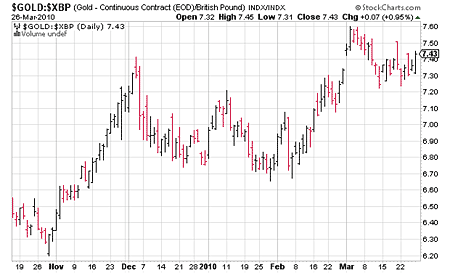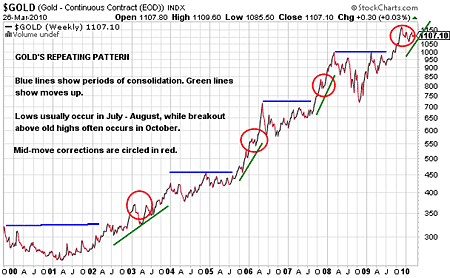Where to next for gold?
So far this year, gold and gold mining shares have performed poorly, while equities continue to rise. But gold's bull run is far from over. Dominic Frisby explains what's been happening with the price of gold, and where we're likely to see it go from here.
A number of you have asked for my latest thoughts on gold. In particular, you've been asking about my spring target of $1,400 an ounce. So I'd like to take a look at it this morning.
Let's be honest, in 2010 gold has been a bit of a dog. So have gold shares. Gold began the year at about $1,120 an ounce. Today it sits at around $1,110.
Gold shares, as measured by the index of unhedged gold miners, the HUI, are down some 10%. The HUI began 2010 at just below 450 and now sits barely above 400. The S&P 500, meanwhile, which began the year at around 1,130, now sits a few percent higher at around 1,170.
MoneyWeek
Subscribe to MoneyWeek today and get your first six magazine issues absolutely FREE

Sign up to Money Morning
Don't miss the latest investment and personal finances news, market analysis, plus money-saving tips with our free twice-daily newsletter
Don't miss the latest investment and personal finances news, market analysis, plus money-saving tips with our free twice-daily newsletter
Worse still, in January's correction, gold and gold shares were hit harder than the stock market. And in the subsequent bounce, they have been laggards. This is not the action I would like to see. I would prefer some signs of leadership.
So what next?
Why you should still hold gold
Looking first at the longer term, I remain utterly convinced by the gold story.
I can't help but think that the credit-based, fiat monetary system under which we operate is going to end badly. Winston Churchill said, "All previous attempts to base money solely on intangibles such as credit or government edict or fiat have ended in inflationary panic and disaster."
Put simply, we have burdened ourselves with too much debt at almost every level of society, from government to corporate to individual. The simplest way out is some kind of currency devaluation.
Whether this is gradual, as we've seen over the past 12 months, (a pound buys you a lot less than it did a year ago) or comes in a sudden collapse, remains to be seen.
The former is more likely in my view. That has been the pattern of the last 100 years. Even house prices have been constant in sterling terms in 2009-10, although they have been falling if you measure them in foreign currency or gold. Indeed, with interest rates on bank accounts generally below the rate of inflation, saving sterling is a loss-making exercise.

- Why UK property prices are going to fall 50%
- When it will be time to get back in and buy up half price property
Given that most foreign central banks are pursuing similar policies, holding foreign currency is not particularly attractive either. That leaves gold. Indeed, despite a mediocre performance against the US dollar (which I turned bullish on in November) gold is actually up 5% this year against sterling. On 1 January it cost £700 an ounce. It now sits at £740. The chart below shows gold vs sterling.

So what about the $1,400 target?
This is late March, so unless we have a bonanza April it doesn't look like we're going to hit my spring target of $1,400. But let's not throw the towel in on this one just yet.
If you read my column regularly, you'll know that I arrived at this target based on a repeating pattern that gold has shown since 2001. It finds a low, usually in July or August, then embarks on a move up. This move often lasts some six to nine months, and ends in a blow-off top the following spring usually following a sharp 10% correction en route. There then follows a period of range trading which lasts some ten to 18 months, before the next move up.
Below is an illustration of the pattern I am describing:

Of course, there is absolutely no guarantee this pattern will continue to repeat. But it's useful as an exercise to see where we are in the scheme of things. Regarding this move, we had our summer low quite early in July as it happens then we had our break out above the old highs a little early too. That came in late September, rather than October. In December we had our nasty mid-move correction. So the pattern looked good for a repetition. In fact, we may still see $1,400 by May if we have another April like that of 2006.
However, this mid-move correction is continuing for longer than I'd like. Perhaps December was the multi-month blow-off top, and we are now in one of those extended periods of consolidation, when gold bulls can't understand why the price isn't rising with the fundamentals so strong. Perhaps I should be looking at April 2009 as the 'summer low', which would mean we've had our six- to nine-month up-move. We would now be in a period of range trading and consolidation.
It could be a positive that gold hasn't reached $1,400
Reluctantly, I have to admit this now appears to be the case. I'll give it until early May before I declare that target dead in the coffin. But if it's dead, that's actually positive.
I don't like to see gold going too far too fast, as it did in 2006 and 2008. The subsequent corrections are too violent and the consolidations take longer. If we are indeed now in a period of consolidation, it's not likely to last for that long, as the previous upmove was comparatively small.
What's more, it looks as though gold has found its low somewhere in the $1,060 to $1,080 area.
In fact, I see similarities in the chart between now and the 2002-3 upmove, which eventually became a lovely run.
To sum up, in the short-term, I'm quite bullish on gold and gold shares. The spring is often a good season for gold and there seems to be plenty of support just below $1,100. And in the long-term I am convinced everyone should own some. It's essential.
But for now, my spring target of $1,400 looks like it was, well, a little optimistic.
Our recommended article for today
Profit from backyard 'green power'
The government is to meet its renewable energy targets by paying householders to generate electricity at home. But can you really make any money from such a scheme? It's risky, says Merryn Somerset Webb, but the numbers do look good.
Get the latest financial news, insights and expert analysis from our award-winning MoneyWeek team, to help you understand what really matters when it comes to your finances.
MoneyWeek is written by a team of experienced and award-winning journalists, plus expert columnists. As well as daily digital news and features, MoneyWeek also publishes a weekly magazine, covering investing and personal finance. From share tips, pensions, gold to practical investment tips - we provide a round-up to help you make money and keep it.
-
 Profit from leisure sector as consumers go on spending spree
Profit from leisure sector as consumers go on spending spreeThe UK leisure sector had a straitened few years but now have cash in the bank and are ready to splurge. The sector is best placed to profit
-
 Nationwide: Annual house price growth slows to lowest level in almost two years
Nationwide: Annual house price growth slows to lowest level in almost two yearsThe average house price went up by just 0.6% between December 2024 and December 2025, Nationwide Building Society said

